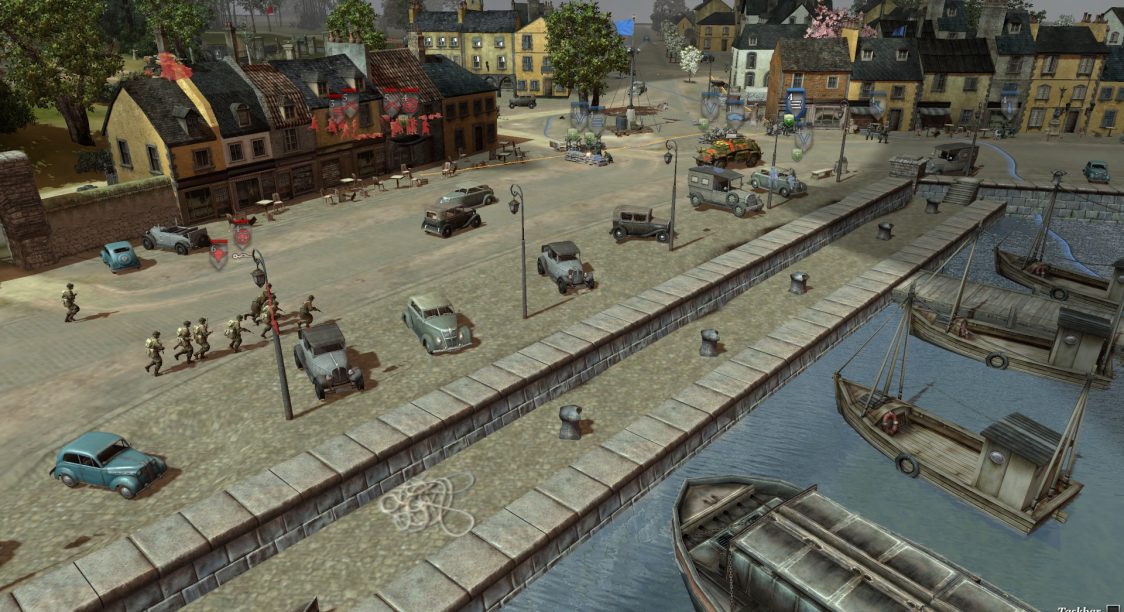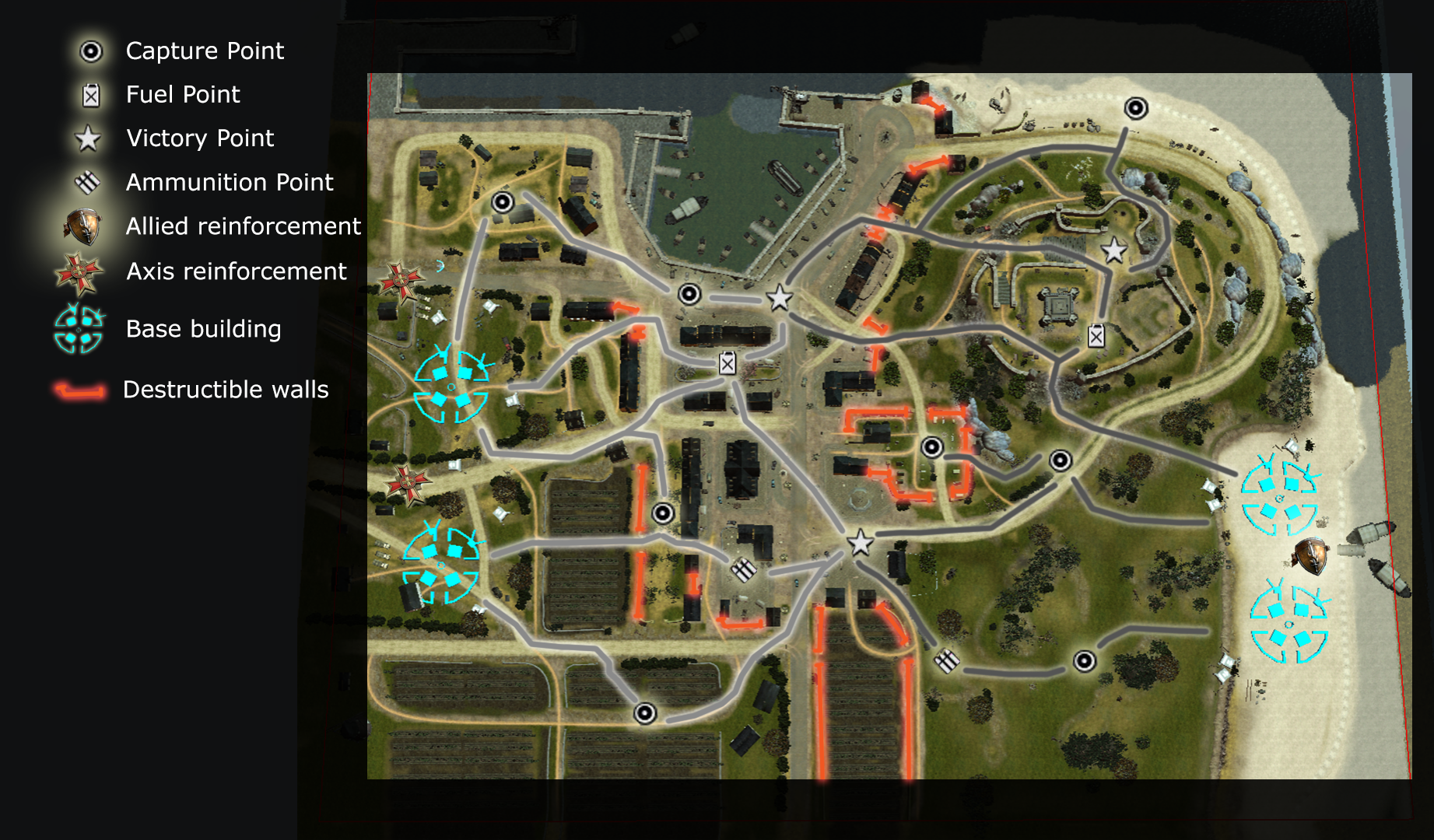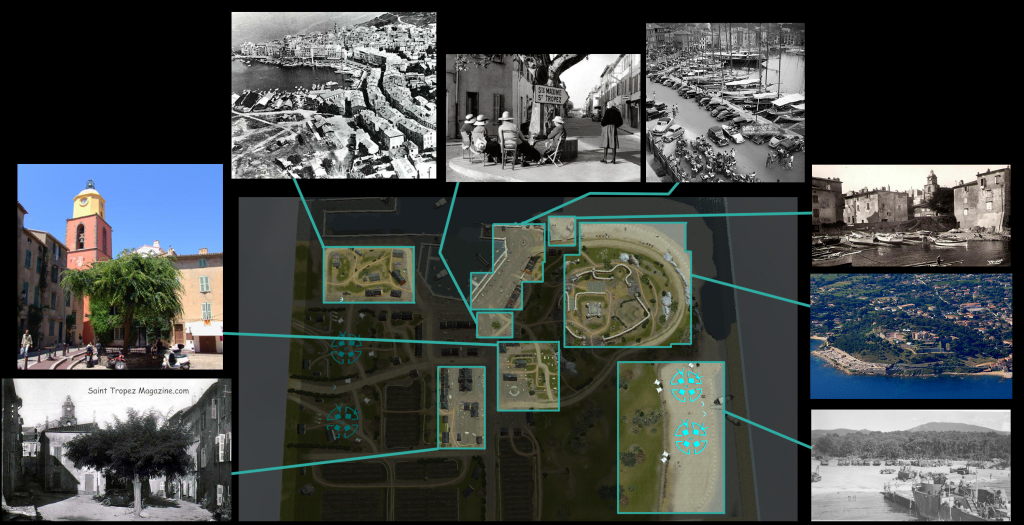Saint Tropez Multiplayer map
Summary
From the start, I had the vision to create a tourist village on the French coast. Where war would feel unfamiliar and the impact of the battle would create a contrast between before and after the battle.
I also wanted to base this vision on an actual historical location and event. I did some research and came across operation Dragoon. Shortly explained, it was when the Allied forces invaded France which at that time was occupied by the Third Reich. It was similar to the invasion of Normandy, Operation Overlord. Operation Dragoon took place on the south coastline of France and one of the villages that were invaded was the tourist village of Saint Tropez. I wanted the gameplay to revolve around tight street walkways with a focus on infantry units and using buildings for cover. To create a dynamic map I used destructible walls that the player can destroy with tanks, this opens up new tactical routes.
Specifications
- [2vs2] & [1vs1] Company of Heroes 2 mutiplayer map
- Asymmetrical map design
- Based on operation Dragoon and Saint Tropez
- Made in three weeks half time
- Tools: Company of Heroes 2 Worldbuilder
- Capture the flag: Each team battle to hold the majority of the three Victory Points in the level
Based on a historical location
Spending time on research and gathering pictures on Saint Tropez and learning how the village developed through time, gave me a good frame of reference to work within. The references helped me define the different parts of the map and my focus was to make it feel like Saint Tropez.
In my research, I learned that Saint Tropez used to be an old fishing village. I tried to convey that with a closed down fishing market. Later on, Saint Tropez became a popular location for the French public. The village got packed with cafés, restaurants, and vineyards. I used the details and stories in the pictures to make the map feel lived in and realistic.
Historical accuracy and Gameplay
There were some aspects that are changed from the original village of Saint Tropez.
I had to scale down the city of Saint Tropez drastically. Trying to keep the defining areas of the Village. I chose to keep the following
- The village church.
- The old fort on the outskirt of the village
- The harbor where people would sit and drink coffe and eat.
- The beach that The Allied forces landed on
- The remenants of the old fishing market
When I realized that Saint Tropez had a fort located on the outskirt of the Village I got super excited to put a fort in my level. But the actual location of the fort was a problem because it was very close to the Victory point the Allied forces defended. The victory points where already hard for the Axis forces to reach. So putting it in a Fortress would make it even harder and unbalanced. The make the VP harder to defend i took the creative freedom to make the fort into a ruin where it was less closed of and more open and easier to attack. I added some props to make it look like the Germans where in the process of renovating the fortress.
Asymmetric and balanced map design
When I do symmetrical maps they tend to look a bit stale and unrealistic. This why I wanted to create a level where the players would feel a difference between the two sides of the map, different sides of the map create a more dynamic environment. The environment was developed to create different tactics and gameplay on each side of the map.
I wanted the asymmetric placement of the Victory Points to convey the feeling that The Axis where the forces that controlled the Village and The Allied forces early on established a foothold on the beach and the outskirt of the village. Where they would attack from the fortress. By having one Victory Point close to The Allies would give them more of a defensive playstyle and The Axis would have more of a mobile playstyle. They would choose one Victory Point to defend (Either The VP in the harbor or the square) and then try to capture either the second VP or the stronghold VP that The Allies is defending. A challenge in an asymmetric design is making the map balanced and also that the design demands a more adaptive play style from the players. It is always risky to demand a certain play style from players, some players may not want to play the game with this play style. In this case, demanding one team to be defensive and another to be mobile depending on which side of the map the player ends up on (the placement of teams are random). I knew the challenge from the start but I also valued the experience of doing an asymmetric map. Because I think asymmetric map design is the future of levels because it opens up interesting gameplay, realistic environments, and more locations to base a level on.
Feedback
About halfway through the development I posted the map in its Alpha stage on Steam and made a post on Reddit. This was a good way of getting feedback from people who played the game. There was a lot of feedback I could use. One person suggested I would place a Railroad in the middle of the Level, the person thought it would improve the gameplay and give the map more open space to move around on. In this case, I could not do a railroad because there had never been a Railroad in Saint Tropez. What I did was to place a larger road in the middle of the level that would achieve the changes he wanted on the gameplay. In this case, it was interesting to work around a problem and come up with a solution with the limitations you sometimes have.
Having people playing the map I could also find where the bottlenecks are and where the battles would take place. Sometimes I would not be pleased with the location and had to make some changes in the level, by blocking off or opening up some routes.
Closing Thoughts
Doing a map for a game like Company Of Heroes 2 in three weeks is a bit tight. There are so many mechanics and abilities for units and vehicles, that you have to think of. If I had more time I would have added more high foliage and thought more about the line of sight in the game, creating some flanking paths. Because of the highly destructible environment in the game, the map gets a bit sparse later in the game when foliage and buildings get destroyed. At that point, the map would need some more work on the terraforming and texture to give it some more details on the later game. I feel that I could still do some minor changes to the balancing of the map, exchange some buildings that had too many windows and would be to advantages for one of the teams. To base it on a historical location and event was a really nice framework and to get feedback from people was super useful. I was pleased with the overall design and flow of the map.



















